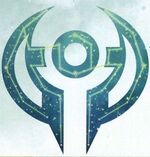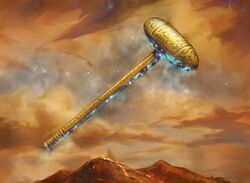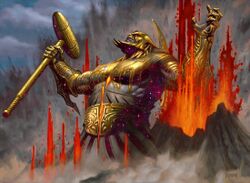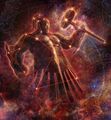Purphoros
| Purphoros | |
|---|---|
| God of the Forge | |
| Information | |
| Colors |
|
| Species | God |
| Birth, Life & Death | |
| Birthplace | Theros |
| Divinity | |
| Abode | Mt. Velus |
| Temples | Akros |

Purphoros (/pʌrfɔːroʊs/, PUHR-fohr-ohs[1]) is the God of the forge, fire, and restless earth on the plane of Theros.[2] He embodies the primal creative force that inspires artisans and fuels the cycle of creation and destruction. Purphoros governs not only metallurgy and craftsmanship but also the obsession and passion required to harness chaotic energy into tangible works. His forge is said to burn deep within Mount Velus, radiating heat that shapes both the land and the lives of mortals. He is a god whose influence is felt through both the inspiration of creation and the devastation of destruction.
Description
Domains
Purphoros is primarily associated with the forge, fire, and the restless earth.[2] He represents the raw creative force of heat and energy within sapient minds, a chaotic power that must be shaped by labor and passion. This creative energy is not uncontrolled chaos but a dynamic process requiring discipline to bring ideas into reality. Purphoros also presides over artisans and obsession, embodying the endless cycle of crafting, destruction, and renewal.
His influence extends beyond physical forging to all forms of creation, guiding mortals in transforming abstract ideas into practical works. He is responsible for introducing bronze to Theros, a key advancement that allowed stronger tools and weapons to be forged. Some of his most devoted followers work with iron, a metal said to originate directly from Purphoros's forge.
Purphoros's forge burns in the heart of Mount Velus, whose blistering heat attracts dragons.[3] His presence brings inspiration to nearby mortals, especially smiths, artists, and warriors, who often honor him with offerings on volcanic slopes or at bonfires.
Personality
Purphoros’s personality is marked by impulsiveness and a mercurial temperament. He is driven by an intense passion for creation and destruction, often alternating between periods of joyous productivity and frustrated anger. He is known for forging exquisite and delicate works only to destroy them in flame and begin anew, reflecting his restless creative mind.
He feels constrained by mortal imagination and is constantly pushing against its limits, yearning to realize ideas that seem just out of reach. This can lead to bouts of despondency followed by destructive outbursts where he reshapes entire landscapes through lava flows or volcanic eruptions.
Purphoros often appears in several forms: a muscular man with coal-hued skin partly covered in mutable bronze, a fiery phoenix, or a bull made of cooling lava. When enraged, he may manifest as an enormous mass of molten lava or a volcanic eruption, appearances that mortals rarely survive witnessing.
Among the gods of Theros, Purphoros is somewhat aloof and distrustful, viewing many of his peers as arrogant. He has few close relationships but maintains a respectful friendship with Thassa, the sea goddess, whose water he cannot destroy or reshape. He resents Kruphix for having impaired his mind during a previous conflict and distrusts the more measured gods like Ephara and Karametra for their focus on order and civilization.
Worship
Purphoros is widely worshiped by artisans, blacksmiths, warriors, and others who rely on creativity and craftsmanship. Most smithies in Theros serve as informal temples to Purphoros, with idols or charms hung on walls to inspire and protect workers. His followers often begin or conclude their work with prayers to him, seeking his favor and inspiration.
Artisans, especially human and satyr smiths and potters, sometimes build altars on volcanic slopes to inhale the fumes and draw inspiration from Purphoros’s forge.[2] Warriors honor him by lighting bonfires before battle, while potters inscribe their works with markings to pay tribute.
Purphoros’s worship is closely tied to the material world and the process of transforming raw materials into objects of power or beauty. Small fires lit in his honor, sometimes burning wooden models or drawings, symbolize the spark of inspiration and the sanctity of creation.
Signature Item

Purphoros wields Akmon, a massive hammer whose head resembles an anvil. A single strike from Akmon can melt earth into molten lava, and when it strikes metal, each spark can become a new enchantment, some capable of taking on life. Purphoros used Akmon to forge legendary beings such as the oreads, said to be formed from stray coals of his forge[4], and the manticore, whose bronze tail, silver teeth, and heart of hate were all crafted by the forge god.[5]
History
Purphoros once created the Sword of Chaos to challenge the sun god Heliod. This weapon was powerful enough to harm divine beings.[6] Their battle disrupted the celestial resting place of the ancient Hydra Polukranos, the World Eater, who subsequently rampaged through Theros until sealed by Heliod and Nylea.
During this conflict, the Planeswalker Elspeth Tirel arrived on Theros and witnessed Purphoros's sword being cast aside. She claimed the sword for herself and later departed the plane.
Later, Purphoros was among the gods affected by the Silence of the Gods, a mystical event that left the gods unable to directly influence mortal lives for a time.[7]
When Heliod ordered his champion Daxos to purge the city of Meletis of all other gods’ influence, Purphoros and the other deities responded by summoning champions from the Underworld. Purphoros’s champion was Anax, former king of Akros. Purphoros's goal in this conflict was to reshape the world through fire and invention.[8]
Inspiration
Purphoros’s character is inspired primarily by Hephaestus, the Greek god of fire, metalworking, and sculptors. His name, however, derives from the Greek term for 'torchbearer' and is often linked with Prometheus, the bringer of fire and creative knowledge to humanity.
Story appearances
Gallery
-
Purphoros, God of the Forge. Art by Eric Deschamps.
In-game references
- Represented in:
- Associated cards:
- Depicted in:
- Quoted or referred to:
- Archetype of Aggression
- Boulderfall
- Demolish (Theros)
- Dreamstalker Manticore
- Ephara, Ever-Sheltering
- Fearsome Temper
- Flamecast Wheel
- Forgeborn Oreads
- Incendiary Oracle
- Magma Jet (Modern Masters 2017)
- Magma Spray (Journey into Nyx)
- Magmatic Insight
- Mount Velus Manticore
- Opaline Unicorn
- Scouring Sands
- Searing Blood
- Spark Jolt
- Spawn of Thraxes
- Terror of Mount Velus
References
- ↑ Wizards of the Coast (September 26, 2013). "Theran Pronunciation Quiz". magicthegathering.com. Wizards of the Coast. Archived from the original on 2021-04-30.
- ↑ a b c Wizards of the Coast. (2013). Theros Player's Guide. Hasbro.
- ↑ Flavor text of Terror of Mount Velus (Theros Beyond Death).
- ↑ Flavor text of Forgeborn Oreads (Journey into Nyx).
- ↑ Flavor text of Dreamstalker Manticore (Theros Beyond Death).
- ↑ Wizards of the Coast (December 16, 2019). "The Theros Beyond Death Story on Cards". magicthegathering.com. Wizards of the Coast.
- ↑ Jenna Helland (April 2014). "Theros: Godsend, Part I." Wizards of the Coast. ISBN 978-0-7869-6556-4.
- ↑ Flavor text of Omen of the Forge (Theros Beyond Death).
External links
- The Magic Creative Team (August 21, 2013). "Planeswalker's Guide To Theros part 1". magicthegathering.com. Wizards of the Coast.
- Theros: Godsend, Part I
- Journey into Nyx: Godsend, Part II


